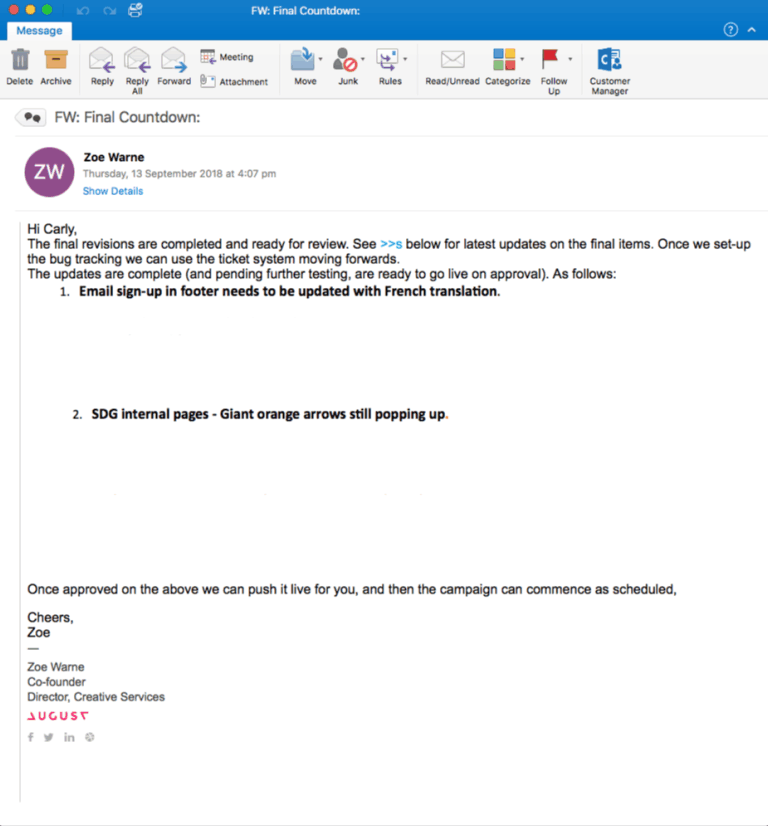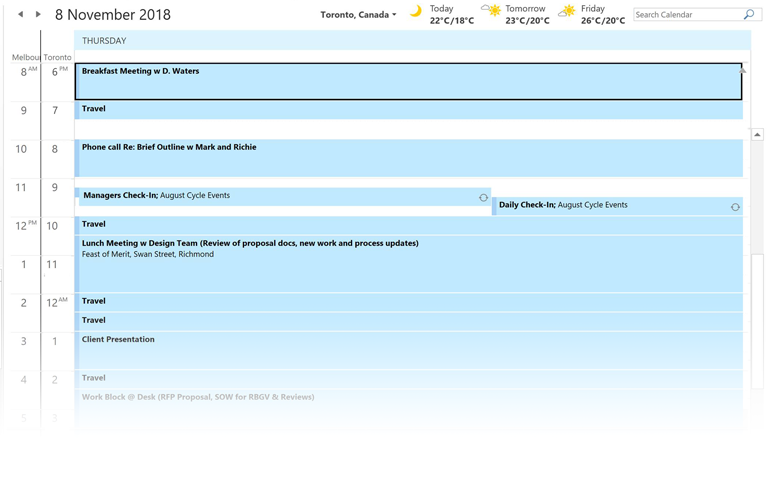- |
- |

The way we work is changing. Today, work is more flexible, accommodating, and empathetic to different ways of interacting and collaborating, from around the world. But that doesn’t necessarily make it simple. Or convenient.
That’s why I’ve collected all my tried-and-true techniques and put them together in this handy, definitive guide. To make your long-distance working life a little simpler. A little more convenient.
Many organizations look at remote teams as an opportunity to grow their business into new markets, expand their talent pool or provide more family-friendly arrangements for staff. While there are tremendous benefits to remote teams, there are also a variety of considerations and behaviours that become vital. Things that are important for any workplace—such as transparent communications and processes—become especially relevant for people working ’round the world.
Remote working can be a tough gig. There’s no way around it.
With the August team spanning Canada, the UK and Australia, we’re no strangers to challenging time differences, early morning conference calls, and overnight Slack updates. It’s truly a 24-hour operation that never sleeps.
We’ve made huge strides to better accommodate our remote Augies—including myself in Toronto—so I’m sharing some experience firsthand and have reached across the pond(s) to our offices in both the UK and Australia for further input and insights.
From finding new ways to better brief in new work and deliver on international deadlines, to ensuring we’re across meetings and team shenanigans, there’s a raft of ideas your team can employ to make remote workers feel at home. Wherever you are.
I welcome more tips in the comments, so we can grow this list to be even more helpful. Let’s go!
1. Become a black-belt at communication.
Communication is essential for any workplace, remote or otherwise. Throw in a few thousand miles and multiple time zones, and poor communication amplifies small issues into a screaming chorus.
For example, it’s a real challenge—especially with daylight savings—to get Melbourne, Manchester and Toronto online at the same time. In some situations, we need to be prepared to break our ground rule of conducting ‘one conversation’ and have the same conversation multiple times to make sure it’s covered off with team members and clients alike.
Tip: Choose face-time to save time.
There’s research to suggest that face-to-face communication is up to 34 times more successful than sending an email. When face-to-face isn’t possible, there are still a bunch of ways to reach out, without resorting to a hastily written Slack message, where tone or content can easily be misconstrued.
Things like body language, tone of voice and phrasing can majorly impact the way a message is communicated, and the content of the message received. When you’re working remotely, nuance and context is easily lost in translation.

Sometimes Ursula says it best.
Being hyper aware of things like tone and word choice can make all the difference between the way your message is read and consumed, and even impact the response you receive. Tone, while not everything, is the quiet communications killer. Keep an eye on it and ‘ABC’—Always Be Checking—to ensure your message is received the way it was intended. Simply asking the recipient to play back what they understood is a great way to ensure clarity.
Tip: Go beyond text to make things clear.
When it comes to communicating with remote teams, don’t rely soley on text communication (see our point on tone above). Screenshots are better than plain text; adding squiggles to highlight certain concepts and notes, even more so.

Squiggles on screenshots can be crude, but they’re highly effective and efficient.
Audio takes it up another level. Even just a recorded message on WhatsApp or Voice Recorder, shared on Slack, helps to keep tone in check and can help convey ideas more effectively.
Screencasts with voiceover are even better still—and video recording trumps them all. If you’re trying to communicate something especially important, live video conferencing is always the way to go. Even if it means waiting an extra day to align schedules. Always aim for the live video option and work backwards from there.
Don’t underestimate the lost time, money and stress that miscommunication through the wrong channels can cause.
When pictures can be digested up to 60,000 times faster than words, make an appropriate choice based on the importance of the message. Don’t be lazy and opt for an instant message or email, when something like a screencast would better support the information you’re trying to convey.
Tip: Emoji your acknowledgement.
It’s essential that remote team members are acknowledged as part of the team in day to day conversations. Whenever they share ideas or contribute to a Slack thread with questions or food for thought, something as simple as responding to the post with an emoji can be a quick, efficient and friendly signal that their voice has been heard.

Emojis are a staple across our Slack channels.
Tip: Embrace the ‘rainbow conversation’.
If you absolutely must use text-based communication, consider ‘batching’ everything together.
Instead of sending multiple individual messages throughout the day, just send one with everything in it.
Try sending longer emails in numbered lists and ask that your respondee reply ‘in line’. In other words, add comments with your initials and a “>>” in colors, with your answers or questions on the numbered points in a different color. It’s easy to follow the conversation and responses visually, rather than sifting through a huge chunk of indiscriminate text.
We call these ‘rainbow conversations’.

A rainbow conversation in action.
And while there’s only an email signature at the end of this rainbow—rather than a pot of gold—they’re worth their weight in gold in the time you’ll save.
Tip: When it comes to plain text, context is key.
Remember that context often gets lost over emails or messaging platforms such as Slack.
If you absolutely must resort to text, provide as much information as possible so the recipient understands:
- The context of the message.
- What type of response you are looking for.
- When you expect or require their input.
- Why you require their input.
For example: ‘To move forward with the client here, I will need your input by 10am your time tomorrow (Wednesday) to enable enough time to get it back to them for approval.’
It sounds obvious, but simply telling the person why you need their response by a certain time helps with clarity, expectations, and empathy on both sides of the conversation.
Another easy way to provide clarity through context is by including all necessary links or related material in that email.
Tip: If all else fails, ask for people’s preferences.
It’s also worthwhile asking your colleagues (and clients, for that matter) how they like to receive information. This little question can go a long way in helping make life easier for everyone. Ask whether they prefer phone, Slack or email, and whether those preferences change based on context.
2. Create an inclusive culture. Exclusively.
Remote team culture should become your work’s general culture. Find ways to keep improving comms with your remote teams and make sure it’s part of your organization’s day-to-day vibe—to always think globally and consider long-distance teammates.
Each member of your team needs to be on board with engaging, accommodating and representing their remote co-workers. Some of the tips we use to promote an inclusive approach include:
Tip: Don’t forget your manners.
Always remember to say hello and goodbye to remote participants, especially in pre-recorded videos they watch later—as well as everyone else—when using any channel. It’s a simple one, but it’s easy to forget.
Likewise, ensure you create space for remote team members to speak up and be heard, whether that is via a chat feature within video conferencing tools (ours plays a loud sound when there is a comment or question from someone dialing in remotely) or just make sure you’re aware that others may want to contribute even though they can’t be seen in the room.
Tip: Record everything so that others can re-visit.
Any opportunity to audio record or film something, take it. Whether it’s a check-in, project W.I.P. or full team meeting. It serves as an inclusive opportunity for remote workers to stay connected and watch it back later. Try including an extra shout out to them in the video too.

We record video conferences for every important meeting so that remote workers can get a tactile sense of how the conversation played out—or join in if they’re online.
A little goes a long way, and encouraging and acknowledging their participation means a lot for the person who is far away. While I’m on this, make sure you take the time to respond. If a remote staff member does comment after the fact, on a video or post that is shared—there is nothing worse than being encouraged to participate, only to end up having that participation being ignored.
Plus, if someone is explaining something interesting and goes off topic—try filming or recording it (with their permission of course) and share these snippets in the appropriate channels. It’s a nice way to stay across other interesting conversations, that may not be strictly work related, as FOMO on office in-jokes is a real thing. 😉
Tip: Team up for conference calls.
Team up and record duo-video calls to share tools, knowledge or background information on projects. We did this recently on some new internal training at August and it was great to see both faces (one in Melbourne and one in Manchester) side-by side on the same screen.
Similarly, include all team members in onboarding for new team members. It’s a great way to spread the load of training a new team member, while introducing them to your remote team culture, and sharing the responsibility for the success of a new colleague’s first experience of the team.
Tip: Don’t forget about fun.
There’s no real ‘rule’ here. It’s more about the personality of your team. As an example, we celebrate every August birthday consistently: wherever you are in the world, you will always get an awesome cake and embarrassing birthday song sung to you.

Birthdays are a delicious, office-wide affair.
I even had a cute voucher for cupcakes emailed to me when it was my birthday, so I could go and get some locally.
3. Schedule yourself for success.
Managing your schedule as a remote worker is essential. Having regular timings to reply to emails, chat to team members or catch some downtime can help you establish your remote routine. Scheduling meetings across time zones, with multiple attendees is no easy feat—we find this tool is great.
Likewise, some calendars allow you to run multiple time zones: for example, I have mine set to both Toronto and Melbourne times, so I can see immediately the time I am suggesting for a meeting and try not to aim for midnight.
Tip: Account for travel time.
By ensuring your calendar is up to date, including travel time to and from meetings (this is a huge one and a great tip a colleague once shared with me), your team can be better informed on when they can reach a remote worker. Your calendar should be their first port of call, so it must be accurate.

Fully stacked and scheduled.
Tip: Think of cancellations as opportunities.
If something gets cancelled and you know people have been trying to reach you, let them know you’re available in general communications channels. You’ll be surprised at how often that can make someone’s day and result in an impromptu chat or friendly exchange. It all adds to the feeling of connectedness, which is what this is all about.
4. Connect with local communities.
Just because you’re working away from your team or organization, doesn’t mean you can’t get involved in your local community.
Tip: Network, network, network.
For my role, networking is key, but further connecting with fellow marketers, designers or developers at local events or meetups is a great way to get some industry facetime on your home ground. Not just for networking, but for general good times, sharing and gaining local tidbits and knowledge.
Tip: On that note, don’t forget to enjoy yourself, too.
There’s no reason why meetups need to be all work and no play. Spend time in your community in a way that inspires you: look into volunteering opportunities, traipse around parks or gardens, or tuck into some local cuisine.
5. Look after number one.
Whether you’re pulling early mornings or late nights to catch conference calls, waiting for a status update or feeling disconnected from the everyday banter of the office—remote work can be emotionally and physically taxing. You need to make time to ensure you’re looking after your own health and wellbeing.
Tip: Keep up the downtime.
It’s easy to lose sight of how long you spend ‘being online’ for your team. There’s value in setting boundaries to switch off for some well-deserved down time (see the calendar point earlier and share this availability, or in this case, unavailability).

Take some time out. Treat yo’ self.
Tip: Factor in time for your favourite activities.
While getting enough sleep and eating well are important for overall wellbeing, it’s equally essential to take time out to practice additional self-care. Do something that makes you feel awesome, and don’t feel guilty about it.
You’ll be a better you, and more effective if you factor for well-deserved time away from the screen.
6. Don’t let technology create a barrier.
Using tech to stay connected is a given—it’s likely your first point of call when it comes to conveying information or catching up with a team member. Tools like Slack, appear.in and Zoom are just some of the ways we keep in touch with our remote teams here at August, and it’s always nice to have a chat over video rather than reading a message or an email. But there are considerations.
Tip: Upload source files for easier access.
Using a Virtual Private Network between your main office location and the rest of the world isn’t always reliable. When possible, request any required files in advance from someone onsite, or ensure they’re in a shared cloud service where possible e.g. Google Docs, OneDrive. There’s nothing worse than being unable to access a file when you need it most.
7. Reciprocate compassion and flexibility.
Your team, and the technology you use to communicate with them, may be your lifeline while working remotely. It’s worth remembering that, like you, they’re not perfect.
Tip: Patience is a virtual virtue.
People forget to reply to messages and technology can fail in the middle of important meetings. From time-to-time, you may have to work at some unusual times to catch up or collaborate, such as 6am or 10pm. It won’t happen all the time, but when it does, be compassionate and open if that’s what’s required. Your team will be more inclined to do likewise in reciprocation.
Remember, it’s also a two-way street; your team may need to structure their working day to ensure they can reach out to you within your availability.
Tip: Keep calm and carry on.
It’s also important to keep your cool in the face of frustrating tech failures. Audio dropouts and crappy video quality are frequent and unfortunately—read ‘realistically’—just part of the norm of remote working.

Being remote can mean getting comfortable with tech fails.
Encourage the team at home base to try ‘being remote for a day’. Split them off into another room for a team meeting that would usually be recorded for remote members. Experiencing frustrating audio quality or poor video firsthand is a surefire way to empathise with your fellow remote workers and will get it fixed much more quickly.
To wrap up…
With these tips and tricks up your sleeve, I hope your remote working experience creates empathy and sparks ideas for better connection with your team. Feel free to share them around, or include them as a reference for new staff taking on the remote challenge.
If you want to start small, here are a few techniques we’ve found to be most effective:
- Choose the medium for your message with care.
- Keep your calendar up to date, it’s an offline reference point for your team.
- Cancellations can be opportunities to connect.
- Ask for people’s preferences, and openly share your own.
- Keep calm in the face of tech fails and missed comms: we’re all only human.
As always, your thoughts and comments are both welcome and strongly encouraged. Simply add your voice to the comments section below or get in touch—I’d love to learn other ways of interacting on all the remote things. I plan to keep this article updated and grow it out further to become an epic resource, so the more the merrier!
More Articles
Up for some more?
Get your monthly fix of August happenings and our curated Super8 delivered straight to your inbox.
Thanks for signing up.
Stay tuned, the next one isn't far away.
Return to the blog.
